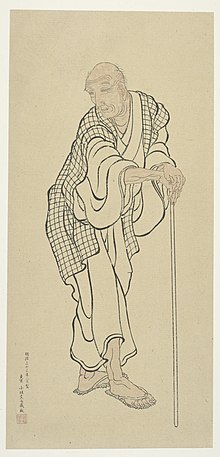
Back Хокусаи, Кацушика Abkhazian Katsushika Hokusai Afrikaans Katsushika Hokusai ALS Кацусика Хокусай ALT ሆኩሳይ Amharic Katsushika Hokusai AN هوكوساي Arabic هوكوساي ARY هوكوساى ARZ কাটুশ্বিকা হ'কচাই Assamese
Hokusai | |
|---|---|
| 北斎 | |
 Self-portrait as an old man | |
| Born | Tokitarō 時太郎 supposedly 31 October 1760 |
| Died | 10 May 1849 (aged 88) Edo, Japan |
| Known for | Ukiyo-e painting, manga and woodblock printing |
| Notable work | The Great Wave off Kanagawa Fine Wind, Clear Morning |
Katsushika Hokusai (葛飾 北斎, c. 31 October 1760 – 10 May 1849), known mononymously as Hokusai, was a Japanese ukiyo-e artist of the Edo period, active as a painter and printmaker.[1] His woodblock print series Thirty-Six Views of Mount Fuji includes the iconic print The Great Wave off Kanagawa. Hokusai was instrumental in developing ukiyo-e from a style of portraiture largely focused on courtesans and actors into a much broader style of art that focused on landscapes, plants, and animals. His works had a significant influence on Vincent van Gogh and Claude Monet during the wave of Japonisme that spread across Europe in the late 19th century.
Hokusai created the monumental Thirty-Six Views of Mount Fuji as a response to a domestic travel boom in Japan and as part of a personal interest in Mount Fuji.[2] It was this series, specifically, The Great Wave off Kanagawa and Fine Wind, Clear Morning, that secured his fame both in Japan and overseas.[3]
Hokusai was best known for his woodblock ukiyo-e prints, but he worked in a variety of mediums including painting and book illustration. Starting as a young child, he continued working and improving his style until his death, aged 88. In a long and successful career, Hokusai produced over 30,000 paintings, sketches, woodblock prints, and images for picture books in total. Innovative in his compositions and exceptional in his drawing technique, Hokusai is considered one of the greatest masters in the history of art.
- ^ Nussbaum, Louis Frédéric. (2005). "Hokusai" in Japan Encyclopedia, p. 345.
- ^ Cite error: The named reference
smithwas invoked but never defined (see the help page). - ^ Kleiner, Fred S. and Christin J. Mamiya, (2009). Gardner's Art Through the Ages: Non-Western Perspectives, p. 115.